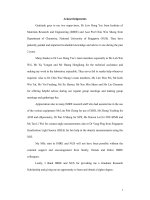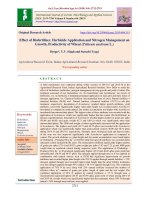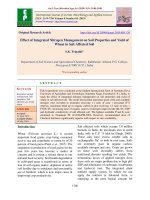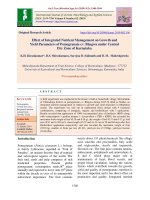Effect of integrated nitrogen management on yield of rice and chemical properties of sodic soil
Bạn đang xem bản rút gọn của tài liệu. Xem và tải ngay bản đầy đủ của tài liệu tại đây (213.85 KB, 8 trang )
Int.J.Curr.Microbiol.App.Sci (2019) 8(5): 1289-1296
International Journal of Current Microbiology and Applied Sciences
ISSN: 2319-7706 Volume 8 Number 05 (2019)
Journal homepage:
Original Research Article
/>
Effect of Integrated Nitrogen Management on Yield of Rice and
Chemical Properties of Sodic Soil
M.S. Jakasaniya, Kiranben J. Khokhariya, R.D. Shinde* and Astha Pandey
Department of Soil Science and Agricultural Chemistry, B.A. College of Agriculture,
Anand Agricultural University, Anand- 388 110, India
*Corresponding author
ABSTRACT
Keywords
INM, Rice, Soil
properties and Yield
Article Info
Accepted:
12 April 2019
Available Online:
10 May 2019
A field experiment on “Effect of integrated nitrogen management on yield of rice and
chemical properties of sodic soil” was conducted at the Agronomy Farm, College of
Agriculture, Anand Agricultural University, Vaso during kharif season 2017. The
experiment was laid out in a randomized block design with ten integrated nitrogen
management (INM) treatments and four replications. Experimental result revealed that the
treatment receiving 50% RDN through castor cake + 50% RDN through inorganic
fertilizer (T7) recorded significantly higher grain yield (4461 kg ha-1) as compared to
application of 100% RDN through inorganic, FYM and vermicompost but it was at par
with rest of the treatments. However, straw yield (7974 kg ha-1) was observed to be
significantly higher with the treatment receiving application of 100% RDN through castor
cake (T4) than other treatments except treatment receiving 100% RDN through FYM (T2)
as well as 50% RDN through castor cake and 50% RDN through inorganic fertilizer (T 7).
The organic carbon content of soil as well as available status of nitrogen, phosphorus,
potassium were remarkably improved and also significantly reduced the ESP after harvest
of rice crop due to the application of treatment receiving organic manures alone or in
combination with inorganic fertilizers.
Introduction
The expected increase in world’s population
(9.6 billion by 2050) needs food productivity
to step up within few decades (Pitaman and
Lauchili, 2002). Unfortunate’s extensive areas
of irrigated lands are unproductive, due to the
accumulation of salts in the soil profile
occupied by the root systems. Salt affected
soils are mostly unproductive unless excess
salts are reduced or removed. These soils
occur mostly in arid and semiarid climate and
also found in coastal areas where soils are
inundated by ocean or sea water. Salt affected
soil has been estimated about 67 lakh ha of
land in India (Anonymous, 2017), in which
the highest area of salt affected soils reported
in Gujarat (22 lakh ha). Maintaining and
restoring the quality of soil is one of the great
challenges of our time. Soil fertility is one of
the vital features controlling yields of the
crops. Fertility status of salt affected soils is
1289
Int.J.Curr.Microbiol.App.Sci (2019) 8(5): 1289-1296
generally poor because of high pH, excess
amount of exchangeable sodium and low
organic matter and nitrogen content, which
restrict the growth and yield of many crops.
Therefore, salt affected soil must be reclaimed
to maintain satisfactory fertility levels and
improve the soil health.
Integrated
nutrient
supply
involving
combined use of organic and chemical
fertilizer as nutrient sources has been
developed. The use of adequate dose of
organic source coupled with chemical
fertilizers is expected to ensure optimum
growth condition under intensive agriculture
using rice hybrid. Singh et al., (2004) from
Hissar reported that 100 per cent
recommended NPK through chemical
fertilizer, 50 per cent NPK through chemical
fertilizer + 50 per cent N through FYM and
75 per cent NPK through chemical fertilizer +
25 per cent N through FYM in rice-wheat
cropping system gave 39.21, 17.5 and 23.1
per cent higher returns over farmers' practice.
It has been well established that the applied
organic sources not only increase soil fertility
but also improve soil physical��������������������������������������������������������������������������������������������������������������������������������������������������������������������������������������������������������������������������������������������������������������������������������������������������������������������������������������������������������������������������������������������������������������������������������������������������������������������������������������������������������������������������������������������������������������������������������������������������������������������������������������������������������������������������������������������������������������������������������������������������������������������������������������������������������������������������������������������������������������������������������������������������������������������������������������������������������������������������������������������������������������������������������������������������������������������������������������������������������������������������������������������������������������������������������������������������������������������������������������������������������������������������������������������������������������������������������������������������������������������������������������������������������������������������������������������������������������������������������������������������������������������������������������������������������������������������������������������������������������������������������������������������������������������������������������������������������������������������������������������������������������������������������������������������������������������������������������������������������������������������������������������������������������������������������������������������������������������������������������������������������������������������������������������������������������������������������������������������������������������������������������������������������������������������������������������������������������������������������������������������������������������������������������������������������������������������������������������������������������������������������������������������������������������������������������������������������������������������������������������������������������������������������������������������������������������������������������������������������������������������������������������������������������������������������������������������������������������������������������������������������������������������������������������������������������������������������������������������������������������������������������������������������������������������������������������������������������������������������������������������������������������������������������������������������������������������������������������������������������������������������������������������������������������������������������������������������������������������������������������������������������������������������������������������������������������������������������������������������������������������������������������������������������������������������������������������������������������������������������������������������������������������������������������������������������������������������������������������������������������������������������������������������������������������������������������������������������������������������������������������������������������������������������������������������������������������������������������������������������������������������������������������������������������������������������������������������������������������������������������������������������������������������������������������������������������������������������������������������������������������������������������������������������������������������������������������������������������������������������������������������������������������������������������������������������������������������������������������������������������������������������������������������������������������������������������������������������������������������������������������������������������������������������������������������������������������������������������������������������������������������������������������������������������������������������������������������������������������������������������������������������������������������������������������������������������������������������������������������������������������������������������������������������������������������������������������������������������������������������������������������������������������������������������������������������������������������������������������������������������������������������������������������������������������������������������������������������������������������������������������������������������������������������������������������������������������������������������������������������������������������������������������������������������������������������������������������������������������������������������������������������������������������������������������������������������������������������������������������������������������������������������������������������������������������������������������������������������������������������������������������������������������������������������������������������������������������������������������������������������������������������������������������������������������������������������������������������������������������������������������������������������������������������������������������������������������������������������������������������������������������������������������������������������������������������������������������������������������������������������������������������������������������������������������������������������������������������������������������������������������������������������������������������������������������������������������������������������������������������������������������������������������������������������������������������������������������������������������������������������������������������������������������������������������������������������������������������������������������������������������������������������������������������������������������������������������������������������������������������������������������������������������������������������������������������������������������������������������������������������������������������������������������������������������������������������������������������������������������������������������������������������������������������������������������������������������������������������������������������������������������������������������������������������������������������������������������������������������������������������������������������������������������������������������������������������������������������������������������������������������������������������������������������������������������������������������������������������������������������������������������������������������������������������������������������������������������������������������������������������������������������������������������������������������������������������������������������������������������������������������������������������������������������������������������������������������������������������������������������������������������������������������������������������������������������������������������������������������������������������������������������������������������������������������������������������������������������������������������������������������������������������������������������������������������������������������������������������������������������������������������������������������������������������������������������������������������������������������������������������������������������������������������nts but it was at par
with treatments T3, T4, T5, T6 and T7 in both
the depths of soil. The available nitrogen after
harvest of rice under treatment T2 was
62.76% and 42.99% higher at 0-15 cm and
15-30 cm depth, respectively as compared to
100% RDN through inorganic fertilizer. The
increase in available N with incorporation of
organic sources may attribute to N
mineralization from organic manures. The
suitable soil condition under organic sources
might have helped the mineralization of soil
N leading to build up of higher available N
(Kumar et al., 2012).
Among the different treatments, treatment T4
(100% RDN through castor cake) was
recorded maximum value of available
phosphorus (42.23 kg P2O5 ha-1) in 0-15 cm
depth and treatment T2 (100% RDN through
FYM) was recorded maximum value (45.10
kg ha-1) in 15-30 cm depth of soil after
harvest of rice, which was significantly higher
as compared to rest of the treatments except
treatments T2, T3, T6 and T10 in 0-15 cm and
treatments T3, T4, T8, T9 and T10 in 15-30 cm
soil depth. The available phosphorus after
harvest of rice under T4 was 45.72 % and T2
was 40.84 % higher as compared to 100%
RDN through inorganic fertilizer in 0-15 and
15-30 cm, respectively. This might be due to
increasing in available P2O5 content of soil
with FYM application may be due to greater
mineralization of organic P, production of
organic acids making soil-P more available.
Similar findings are observed by Yaduvanshi
(2001).
Effect of integrated nitrogen management on
available potassium in 0-15 cm depth of soil
was found to be non-significant whereas in
15-30 cm depth of soil it was found
significant. Among the different treatments,
1292
Int.J.Curr.Microbiol.App.Sci (2019) 8(5): 1289-1296
treatment T4 (100% RDN castor cake) was
recorded significantly higher available
potassium (272.2 kg K2O ha-1) after harvest of
rice in 15-30 cm depth of soil as compared to
treatments T1, T8, T9 and T10 but was
remained statistically at par with treatments
T2, T3, T5, T6 and T7. The application of
organic manure might also be attributed to
direct addition of potash in available K pool
of the soil which ultimately improved the
availability of potash at harvest. Similar
findings were also observed by Singh et al.,
(2005) and Singh and Singh (2007).
Table.1 Chemical composition of FYM, vermicompost and castor cake
Parameters
FYM
0.45
Vermicompost
0.72
Castor
cake
4.2
Total nitrogen content (%)
Total phosphorus content
(%)
0.40
1.39
1.8
Total potassium content (%)
0.50
0.60
1.3
Method followed
Kjeldahl digestion method
(Jackson, 1973)
Vanadomolybdo phosphoric
acid yellow colour method
(Jackson, 1973)
Flame photometry
(Jackson,1973)
Table.2 Effect of integrated nitrogen management on grain and straw yield of rice
Sr.No.
Treatments
T1
T2
T3
T4
T5
Control (RDN: 100 kg N ha-1 through inorganic fertilizer)
100% RDN through FYM
100% RDN through vermicompost
100% RDN through castor cake
50% RDN through FYM + 50% RDN through inorganic
fertilizer
50% RDN through vermicompost + 50% RDN through
inorganic fertilizer
50% RDN through castor cake + 50% RDN through
inorganic fertilizer
25% RDN through FYM +75% RDN through inorganic
fertilizer
25% RDN through vermicompost + 75% RDN through
inorganic fertilizer
25% RDN through castor cake + 75% RDN through
inorganic fertilizer
S. Em. ±
CD at 5%
CV %
T6
T7
T8
T9
T10
1293
Grain
yield
(kg ha-1)
3084
3379
3289
4016
4346
Straw
yield
(kg ha-1)
5755
7060
6637
7974
6892
4039
6004
4461
7129
3894
6765
3969
6339
4331
6820
243
706
12.54
318
925
9.47
Int.J.Curr.Microbiol.App.Sci (2019) 8(5): 1289-1296
Table.3 Effect of integrated nitrogen management on chemical properties of soil after harvest of rice
Sr.
No.
T1
T2
T3
T4
T5
T6
T7
T8
T9
T10
Treatments
Control (RDN: 100 kg N ha-1
through inorganic fertilizer)
100% RDN through FYM
100% RDN through
vermicompost
100% RDN through castor cake
50% RDN through FYM + 50%
RDN through inorganic fertilizer
50% RDN through
vermicompost + 50% RDN
through inorganic fertilizer
50% RDN through castor cake +
50% RDN through inorganic
fertilizer
25% RDN through FYM +75%
RDN through inorganic fertilizer
25% RDN through
vermicompost + 75% RDN
through inorganic fertilizer
25% RDN through castor cake +
75% RDN through inorganic
fertilizer
S. Em. ±
CD at 5%
CV %
pH
EC
(dS m-1)
Organic
Available N
Available
Available
Carbon
(kg ha-1)
P 2O 5
K2O
(%)
(kg ha-1)
(kg ha-1)
0-15 15-30 0-15 15-30 0-15 15-30 0-15
15-30
cm
Cm
cm
cm
cm
cm
cm
cm
0.20
0.24 150.3 175.5 28.98 32.02 226.5
233.9
ESP (%)
0-15
cm
17.80
15-30
cm
17.61
0-15
cm
8.59
15-30
cm
8.34
0-15
cm
0.71
15-30
cm
0.63
8.47
8.44
8.27
8.04
0.62
0.61
0.59
0.59
0.43
0.35
0.55
0.47
244.6
228.9
251.0
247.8
41.45
40.96
45.10
43.53
245.3
245.8
264.8
255.4
13.38
14.55
13.71
14.80
8.38
8.52
8.25
8.15
0.60
0.63
0.54
0.55
0.42
0.38
0.54
0.46
243.7
232.3
244.6
228.9
42.23
34.55
41.35
31.12
262.8
239.3
272.2
271.5
14.38
15.53
14.92
15.90
8.49
8.28
0.63
0.55
0.42
0.52
225.8
225.8
36.33
37.23
233.2
266.8
15.62
15.99
8.37
8.30
0.62
0.52
0.36
0.46
232.1
228.9
34.55
36.85
235.9
259.4
15.37
15.61
8.58
8.19
0.63
0.53
0.33
0.48
207.0
207.0
33.03
40.17
237.9
235.2
15.63
16.14
8.52
8.31
0.65
0.57
0.37
0.45
207.0
205.4
34.03
39.06
232.5
242.6
15.35
15.71
8.46
8.31
0.64
0.53
0.39
0.45
203.7
213.3
36.08
42.21
233.2
247.3
15.15
15.85
0.15
NS
3.54
0.13
NS
3.20
0.03
NS
8.91
0.01
0.03
3.71
0.03
0.07
13.87
0.02
0.07
10.06
11.17
32.40
10.27
10.82
31.39
9.71
2.34
6.79
12.94
2.09
6.06
10.75
8.22
NS
6.87
8.45
24.52
6.63
0.65
1.89
8.54
0.59
1.70
7.50
1294
Int.J.Curr.Microbiol.App.Sci (2019) 8(5): 1289-1296
Exchangeable Sodium Percentage (ESP)
The data on exchangeable sodium percentage
after harvest of rice influenced by integrated
nitrogen management is presented in Table 3.
The effect of different treatments of INM was
found significant on ESP of both the soil
depths after harvest of rice. The significantly
minimum ESP values, 13.38% and 13.71%
were recorded under the treatment receiving
100% RDN through FYM (T2) in 0-15 cm
and 15-30 cm soil depth, respectively, but it
was at par with treatments T3, T4 and T10 in 015 cm depth and with treatments T3 and T4 in
15-30 cm soil depth. With different sources of
organic manure under study, the resulted
reductions of ESP were 24.83%, 18.25% and
19.15% and 22.14%, 15.95% and 15.27%
with application of 100% RDN through FYM,
vermicompost and castor cake over
application of 100 % of inorganic fertilizer in
0-15 cm and 15-30 cm depths, respectively.
Similarly, Sarwar et al., (2008) and Virdia
and Mehta (2009) also reported that
application of organic manure alone or in
combination of inorganic fertilizer reduced
the ESP. The application of organic matter to
salt-affected soil promotes flocculation of
clay minerals, which is an essential condition
for the aggregation of soil particles. It also
plays an important role in increasing bio pores
spaces, which increase Na+ leaching and
consequently decreased the exchangeable
sodium percentage (Lakhdar et al., 2010).
It can be concluded that integrated use of
organic manure (FYM, vermicompost and
castor cake) with inorganic fertilizers could
be beneficial to maintain sustainable rice
yield as well as to improve the soil chemical
properties and reclamation of sodic soil as
compared to inorganic fertilizer alone.
References
Anonymous (2017). Annual Report. Central
Soil Salinity Research Institute, Karnal.
Bafna, A. M., Arvadia, M. K., Gami, R. C.,
Patel, K. G., Patel, Z. N. and Patel, K.
P.
(2010).
Integrated
nutrient
management
on
paddy-sugarcane
cropping sequence. State Level Seminar
on “Organic Farming”-2010, Navsari,
Gujarat, pp: 134-135.
Bahadur, L., Tiwari, D. D., Mishra, J., Gupta,
B. R. (2013). Evaluation of integrated
nutrient management options in ricewheat (Triticum aestivum) cropping
system in reclaimed sodic land. Indian
Journal of Agronomy, 58(2): 137-145.
Das, D.K, (2011). Introductory Soil Science,
Kalyani Publishers, Ludhiana, Haryana.
3rd Edn. pp. 335-336.
Gupta, V. and Sharma, R. S. (2010). Effect of
integrated nutrient management on yield
and nutrient uptake based cropping,
conducted at Jabalpur. Research on
Crops, 11: 239-243.
Jackson, M. L. (1973). Soil Chemical
Analysis. Prentice Hall of India Pvt.
Ltd., New Delhi.
Koushal, S., Sharma, A.K. and Singh, A.
(2011). Yield performance, economics
and soil fertility through direct and
residual effects of organic and inorganic
sources of nitrogen as substitute to
chemical fertilizer in rice-wheat
cropping system. Research Journal of
Agricultural Science, 43(3): 189-193.
Kumar, J. and Yadav, M. P. (2008). Effect of
conjunctive use of organic, inorganic
and bio-fertilizers on growth and yield
attributes, yield and nutrient uptake in
hybrid rice. Research on Crops, 9(3):
511-513.
Kumar, M., Yaduvanshi, N. P. S., Singh, Y.
V. (2012). Effect of integrated nutrient
management of rice yield, nutrient
uptake and soil fertility status in
reclaimed sodic soil. Journal of Indian
Society of Soil Science, 60(2): 132-137.
Lakhdar, A., Scelza, R., Scotti, M., Rao, N.,
Jedidi, L., Gianfreda, C. Abdelly.
1295
Int.J.Curr.Microbiol.App.Sci (2019) 8(5): 1289-1296
(2010). The effect of compost and
sewage sludge on soil biologic activities
in salt affected soil. R.C. Suelo Nutr.
Veg., 10(1): 40-47.
Mishra, V. K. and Sharma, R. B. (1997).
Effect of fertilizers alone and in
combination with manure on physical
properties and productivity of entisol
under rice-based cropping system.
Journal of the Indian Society of Soil
Science, 45: 84-88.
Olsen, S. R., Cole, V. C., Watenable, P. S.
and Dean, L. A. (1954). Estimation of
available phosphorus in soil by
extraction with sodium bicarbonates.
Chemical Abstract, 48(16): pp.1598.
Pitaman, M. G., and Lauchili, A. (2002).
Global impact of salinity and
agricultural ecosystem. In Salinity:
Environment-plants-Molecules;
Lauchili, A., Luttge, U., Eds.; Kluwer
Academic Publisher: Dodrech, The
Netherlands, pp. 3-20.
Sarwar, G., Hussain, N., Schmeisky, H.,
Muhammad, S. (2008). Use of compost
an environment friendly technology for
enhancing rice-wheat production in
Pakistan. Pakistan Journal of Botany,
39(5): 1553-1558.
Sepehya, S., Subehia, S. K., Rana, S. S., and
Negi, S.C. (2012). Effect of integrated
nutrient management on rice-wheat
yield and soil properties in a north
western Himalayan region. Indian
Journal of Soil Conservation, 40: 135140.
Singh, B. and Singh, R. V. (2007).
Comparative performance of rice hybrid
sat different fertility levels under
irrigated
transplanted
condition.
International Journal of Agricultural
Science, 4(2): 485-488.
Singh, K., Singh, R. K., Herojit, A., Zoliana,
S. and Gopimohon, N. (2005). The
economy in fertilizer use, sustaining soil
health and yield of crops could be
achieved only by conjunctive use of
fertilizer, organic and biofertizers.
Journal of the Indian Society of Soil
Science, 53: 107-115.
Singh, Yadvinder, Singh, Bijay, Ladha, J. K.,
Khind, C. S., Gupta, R. K., Meelu, O.
P., Pasuquin, E. (2004). Long-term
effects of organic inputs on yield and
soil fertility in the rice-wheat rotation.
Soil Sci. Soc. America J. 68(3): 845853.
Subbiah, B. V and Asija, G. L. (1956). A
rapid procedure for the estimation of
available nitrogen in soils. Curr. Sci.,
25: 259-260.
Virdia, H. M. and Mehta, H. D. (2009).
Integrated nutrient management in
transplanted rice (Orayza sativa L.).
Journal of Rice Research, 2(2): 99-104.
Yaduvanshi, N. P. S. (2001). Effect of five
years of rice-wheat cropping and NPK
fertilizer use with and without organic
and green manures on soil properties
and crop yields in a reclaimed sodic
soil. Journal of the Indian Society of
Soil Science, 49(4): 714-719.
How to cite this article:
Jakasaniya, M.S., Kiranben J. Khokhariya, R.D. Shinde and Astha Pandey. 2019. Effect of
Integrated Nitrogen Management on Yield of Rice and Chemical Properties of Sodic Soil.
Int.J.Curr.Microbiol.App.Sci. 8(05): 1289-1296. doi: />
1296









